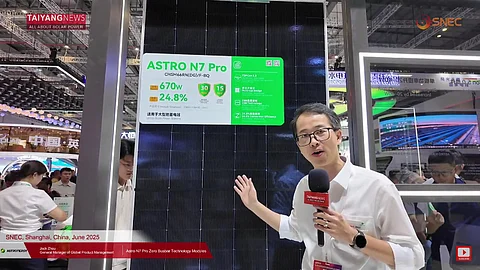

Astronergy’s latest ASTRO N7 Pro series boasts a power output of up to 670 W and a maximum efficiency of 24.8%
The module features the company’s TOPCon 5.0 cell technology, which is based on 0BB metallization
It is expected to be commercially available by H1 2026
The zero busbar (0BB) TOPCon cell-based module, a rare occurrence till last year’s SNEC and Intersolar Europe exhibitions, has witnessed some traction in 2025.
During SNEC, Astronergy, a Chinese PV cell and module-making company, introduced its 0BB TOPCon cell-based product lineup. Jack Zhou, Astronergy’s General Manager of Global Product Management, highlighted the CHSM66RN(DG)/F-BQ module from the company’s latest ASTRO N7 Pro series during a short interview with TaiyangNews.
Based on Zhou’s elaboration and the product datasheet, the showcased model’s key features can be analyzed.
The module, comprising 264 pieces of G12R size TOPCon 1/4 cut cells, is rated for a maximum power of 670 W and an efficiency of 24.8%, claims the company.
It uses the company’s latest 0BB TOPCon cell, based on its TOPCon 5.0 technology.
Without disclosing the details of 0BB metallization, the company shared that it has adopted 0BB + Carrier Film technology route for cell-to-cell interconnection at the module level. It has implemented a process in which 20 ultrathin ribbons are precisely pre-positioned on the surface of 0BB cells using a low-fluidity carrier film. In this method, the ribbons are first laid down, followed by the application of the carrier film. The final step involves completing the soldering and alloying through a low-temperature lamination process.
In terms of electrical gains, 0BB decreases electrical resistance within the solar cell. By eliminating the need for centralized busbars, current can be collected and transported more efficiently across a large number of fine contacts. This helps in increasing efficiency compared to SMBB technology, says Zhou. In addition to the efficiency advantages, incorporating a multi-cut TOPCon cell-based module layout reduces series resistance, boosting module power compared to the half-cut cell-based counterpart. Importantly, the edges of multi-cut cells are passivated to prevent potential leakage losses stemming from surface defects, which act as minority charge carrier recombination centers, added Zhou.
Weighing 31.65 kg, this 2.0 mm front and rear glass-based module has dimensions of 2,382 × 1,134 × 30 mm. According to the datasheet, its rated bifaciality can reach up to 90%. The module also generates additional power from the redirected sun rays, reflected from the embedded LRF film (light redirecting film), which would have been wasted otherwise, placed between the cell-to-cell gap.
This product, expected to be commercially available from H1 2026, will be offered with a product and performance warranty of up to 15 and 30 years, respectively.
Apart from conventional PV modules, Zhou also briefly highlighted a few sample models of perovskite and perovskite-Si-based tandem cells. He explained that, irrespective of the type of bottom-layer crystalline-Si cell technology – HJT or TOPCon – the front perovskite layer absorbs UV or blue light, while the bottom layer absorbs the visible light. By covering a broader spectrum of sunrays, compared to traditional c-Si PV cells, the perovskite-tandem cell yields higher efficiency. Currently, the company’s perovskite tandem cell technology development is in the research and development (R&D) stage. It has a pilot line for this purpose, concluded Zhou.
